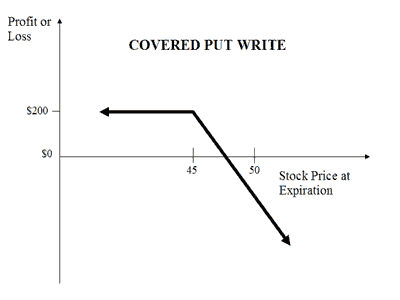Search Options Trading Mastery:
- Home
- Covered Calls
- Covered Put Option Strategy
The Covered Put Option Strategy
You could say that the covered put option strategy is the exact opposite to the covered call. With covered calls, you write call options but you "cover" the potentially unlimited liability associated with doing so, by owning the equivalent amount of the underlying stock. Should the price of the stock rise, the stocks you own will make more money than the call options will lose.
In a covered put option strategy, you write (sell to open) put options and you cover the liability that comes with "sold" positions, by shorting the underlying stock. So a covered put would be structured like this:
| Covered Put Option Strategy |
| Short 100 Shares Sell 1 Put Contract |
Depending on where you choose your strike price for the put options will determine your risk profile. For example, if you sell at the money (ATM) puts then your profit is limited to the premium you collect, should the share price tank.
Your loss to the upside will be the unrealized loss on the short stock position, less the premium you received.
Let's assume the ATM put option price for your intended share shorting exercise, is $2.00.
- This means that you would receive $200 for selling one put contract.
- This $200 would offset the cost of the 100 shares you also need to short sell, to complete the strategy.
Your risk graph would look something like this:

Covered Put Option Strategy - Is It Worth It?
Let's consider a few alternatives:
If you sold 'out of the money' put options, i.e. at a strike price lower than current market price, then you would receive less premium, but should the stock price fall sufficiently, your profit would be greater, due to the decline in share price creating gains before your 'lower' option strike price would be hit.
But if the stock price rises, you are more exposed to loss than if you had sold 'at the money' options. In fact, your potential loss to the upside is theoretically unlimited because there is no ceiling on how high a stock price can rise before option expiration date.
In our abovementioned case, if the underlying rose by $10 per share, then your loss would be $1,000 (10 x 100) less the $200 you had received for selling the options.
Your net loss is therefore $800.
You may have guessed by now, that the covered put option strategy is best implemented in a bearish to neutral market.
It is not only applicable to stocks, but can also be used in the commodity futures options markets, foreign currency options markets, or with index options or ETF options.
One advantage of an 'out of the money' covered put option strategy over the covered call is, that on average, if you catch a falling market at the right time, you make your profits faster than you do using the covered call strategy.
This is because when stock prices fall, the panic that is often behind it forces the price down at a more rapid rate than when it rises.
In summary, the covered put can be used to protect your short share positions from a slight rise in price, or if you're choosing out of the money strikes, increase your profits up to a point.
Recommendation:
If you're into this strategy then you can make it much easier for yourself by using a good market scanner. We have found one of the best services for scanning the markets and finding eligible stocks, is the Market Club Trade Triangle Scanning Service.
You can take a full featured test drive of their services for only $1 for the first month. You get a whole lot more than this, but for Covered Put picks, this is such good value.
***************** *****************
Return to Covered Calls Contents Page
Return to Option Trading Homepage















New! Comments
Have your say about what you just read! Leave me a comment in the box below.